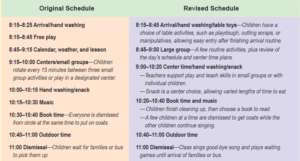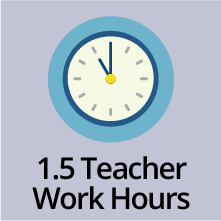
– How do I do this?
– What Barriers Might I Run Into and What Are Solutions?
– Where do I go for more resources?
– References
Early childhood providers/teachers are among the most important people in the social, emotional, and academic development of our young children. The average workday of an early childhood provider/teacher can include many responsibilities: providing direct child care, completing administrative tasks, communicating with parents and guardians, and planning lessons. Providers/teachers may have little to no downtime during their workday. Interviews and surveys of providers/teachers reveal that time pressures are among the most common causes of stress. In a 2012 study, nearly all providers/teachers surveyed reported stress due to the time demands of teaching. The stress caused by time constraints can hinder a provider/teacher’s sense of control over his or her classroom and hinder his or her emotional stability. A study of state-funded preschools found that teachers who report elevated levels of job stress are more likely to suspend or expel children than teachers who report average or low stress.
In the Joint Policy Statement on Expulsion and Suspension Policy in Early Childhood Settings, the U.S. Departments of Education and Health and Human Services recommend that childhood programs “promote teacher health and wellness and ensure that teachers work reasonable hours with breaks.” By allowing providers/teachers to have breaks and time away from the children, teachers may be able to better manage their stress and strengthen the quality of their relationships with their children.
How do I do this?
Have providers/teachers journal their time spent. Providers/teachers can record the time they spend throughout the day and share this record with the administrator or program. Ask them to record specifically the times when they have breaks during the day, if any, and the points when they feel the most stressed. Teachers can use the day planner guide provided by the Virtual Lab School to help record their thoughts, challenges, and experiences for all of their daily activities.
Evaluate the program’s daily schedule. Program directors and providers/teachers can take a critical look at their existing schedule. Use your program’s answers to the day planner guide to help you evaluate the schedule. What do their responses reveal? Program directors and providers/teachers can take a critical look at their existing schedule. Are there numerous times of transition? Do the times of transition correspond with when teachers feel most stressed? Does the schedule allow for any reasonable breaks for the providers/teachers? Determine whether there may be ways for the schedule to be adjusted to allow for brief breaks for the teachers throughout the day and fewer transitions.
Adjust classroom schedule. On the basis of the providers’/teachers’ and director’s evaluation of the schedule, make the necessary changes to the schedule that will best suit the children’s and providers’/teachers’ needs.
Allow time for other responsibilities. Incorporate intentional time into the schedule for teachers to complete administrative and other tasks outside of direct child care responsibilities. Providing opportunities where teachers can complete more of their responsibilities during work hours can reduce the amount of work spent at home and help reduce stress. Take advantage of staff meetings to have providers/teachers share their approaches to create the sense of a support group and professional development among staff.
What Barriers Might I Run Into and What Are Solutions?
Potential Barrier: My program has difficulty finding time for staff to take breaks away from children because of our limited resources and staffing shortages.
Solution: For programs located in the same building as an elementary school, other trained and qualified instructors may be able to help provide additional support for those preschool teachers. Parent volunteers, student teachers or interns, and even nonprofit providers may also be able to help monitor preschool classrooms and offer additional support to providers/teachers.
Potential Barrier: We are a very small program and do not have additional staff to support breaks.
Solution: Consider investing in professional development or in-service days for staff so they get a break. You could also use trained volunteers to help allow for provider/teacher breaks and time management throughout the day. To do this, you could explore partnering with a local college to find early childhood education student interns.
- Check out the list of resources created by the University of California at Los Angeles to help you initiate a volunteer program in your program or school.
- Take a look at the sample schedule below to see how the lead teacher, a teacher aide, and volunteers can work together to staff an entire preschool day and allow for teacher breaks.

Where do I go for more resources?
- Supportive Environmental Quality Underlying Adult Learning (SEQUAL) is a multipurpose tool designed to help early childhood programs examine and improve the workplace environments for their teaching staff. The tool can be used by programs to assess what areas of the workplace environment are supporting best practices and what areas are hindering best practices.
- Check out the list of resources created by the University of California at Los Angeles to help you initiate a volunteer program in your program or school.
- Children are more likely to engage in challenging behavior during times of transition when they are moving from one activity to another. Transition times can often be stressful experiences for teachers. The National Association for the Education of Young Children (NAEYC) suggests that adjusting the schedule to minimize transitions can help decrease instances of challenging behavior. See below for an example of a schedule revised to minimize transitions, and check out NAEYC’s guide for tips on creating an effective transition plan.

Source: Moving Right Along…Planning Transitions to Prevent Challenging Behavior, 2008 - You can also check out Recommendations 2.2 and 2.3 to learn more about strategies that help promote a supportive environment and children’s positive social-emotional development. These strategies can help decrease and prevent challenging behaviors.
References
Day, C., and Quing, Gu. (2009). Teacher Emotions: Well Being and Effectiveness. Foresight Mental Capital and Wellbeing Project, Advances in Teacher Emotion Research (pp. 15-31). Retrieved from http://link.springer.com/chapter/10.1007%2F978-1-4419-0564-2_2
Gillam, W. and Golan, S. (2006). Preschool and Child Care Expulsion and Suspension: Rates and Predictors in One State. Infants and Young Children, 19(3), 228-245.
Gooze, R., Whitaker, R., and Dearth-Wesley, T. (2015). Workplace Stress and the Quality of Teacher-Children Relationships in Head Start. Early Childhood Research Quarterly, 30, 57-69.
Hemmeter, M.L., Ostrosky, M., Artman, K., and Kinder, K. (2008). Planning Transitions to Prevent Challenging Behavior. NAEYC. Retrieved from http://journal.naeyc.org/btj/200805/pdf/BTJ_Hemmeter_Transitions.pdf
US Department of Health and Human Services and US Department of Education. (2014). Policy Statement on Expulsion and Suspension Policies in Early Childhood Settings. Retrieved from https://www2.ed.gov/policy/gen/guid/school-discipline/policy-statement-ece-expulsions-suspensions.pdf
Ylitapio-Mantyla, O., Uusiautti, S., & Maatta, K. (2012). Critical viewpoint to early childhood education teachers’ well-being at work. International Journal of Human Sciences, 9 (1), 458–483.
